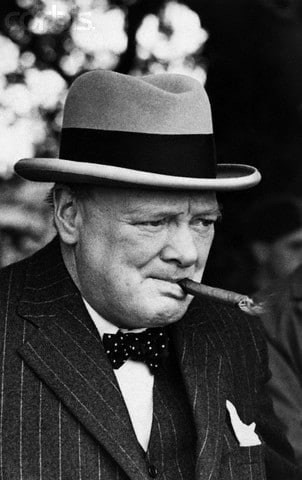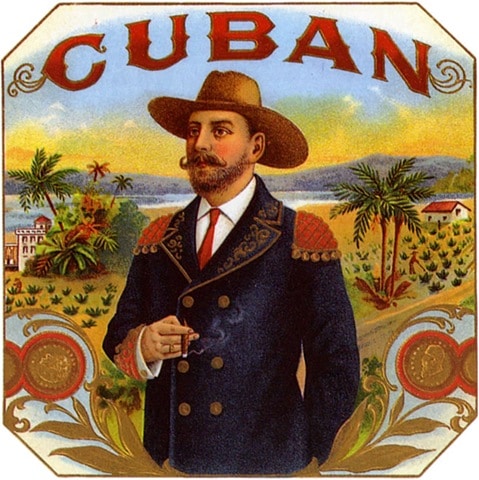
There was once a time when a man with a cigar in his mouth was held in high regard; a time when a young man toasted farewell to adolescence by igniting the end of a cigar that “just happened†to slip out of his father’s humidor. A time where the arrival of a man’s progeny was celebrated with cigars in the hospital’s waiting room. A time when one could find a guillotine right alongside a man’s trusty pocketknife.
A 21-year-old Winston Churchill, on a quest to prove his manliness, ventured to the island of Cuba. It was in Cuba where Churchill began his love affair with the cigar. He described cigars as part of his “rule of life prescribed as an absolutely sacred rite; smoke cigars and drinking of alcohol before, after and if need be during all meals and in the intervals between them.†Churchill was so renowned for his cigar habit that a cigar of especially large magnitude still carries his name today: The Churchill cigar.
There can certainly be some intimidation when you first walk into a well-stocked cigar humidor. How can you possibly tell the difference between a Montecristo and an Ashton? Does it matter if this “Romeo y Julieta†came from the Dominican Republic and not Cuba? (why yes, it does). Fear not. After reading these quick tips on choosing a quality cigar, you’ll have an idea on how to pick a quality cigar. You’ll also be left wondering why you ever thought picking up a pack of Swisher Sweets from the gas station was a good idea.
Anatomy of a Cigar

The head: This is the end you put in your mouth. It’s sealed off and will require cutting; a guillotine is preferred to reduce the chance of smashing the cigar; however, a sharp knife will do. But for the love of God, do not use your teeth!
The foot: This is the side that you light.
The filler: A nice, consistent blend of dried and fermented tobacco.
The wrapper: The outside of the cigar. It varies in color from light to dark. A lot of the cigar’s flavor comes from this outer layer.
Choosing a Cigar
Now that you know your head from your foot, we can move onto choosing a cigar. Check out a local cigar club. They’ll likely have a well-stocked humidor and a knowledgeable tobacconist who will guide you through the selection. When you arrive at the cigar club, you’ll walk into a humidor full of cigars. Humidors help maintain an optimal level of moisture inside the tobacco. If it’s too humid, the tobacco will rot. If it’s not humid enough, the cigars will dry out and lose their flavor and aroma.
If this is your first time smoking a cigar, stay away from the higher-priced ones since, at this point, you won’t be able to truly savor the distinguishing elements of an expensive cigar. Besides, price isn’t the most most important factor in choosing a cigar. There are plenty of cheaper cigars out there that hold top ratings from major cigar publications.
While price isn’t that important when selecting a cigar, cigar construction and tobacco quality are. The cigar’s construction determines how smooth and even the draw is when you smoke it. You can test the construction of a cigar by rolling it between the thumb and index finger of your hand. As you do this, make sure the cigar’s outside doesn’t have any lumps. Also check that the body is not too soft or void of filling. You want the cigar to have a nice even consistency and fill. A rough texture or any other mark of bad construction means a less smooth draw when you inhale. With a well constructed cigar, the ash will maintain the shape of the cigar as it is smoked.
The second important factor when buying a cigar is the tobacco’s quality. You typically can’t determine tobacco quality simply by looking at the outside of the cigar. So how do you know which brands use good quality tobacco? It’s mainly based on reputation. Ask the tobacconist or your friends for recommendations on cigars that use quality tobacco. It’s usually a safe bet to go with larger brands. The big cigar brands tend to use higher quality tobacco in their cigars because they usually have first dibs on the quality stuff. In your quest to find cigars that use quality tobacco, just remember to purchase one cigar at a time instead of buying boxes. You don’t want to be left with a box of crummy cigars you’ll never smoke.
Now before you go running off to your local cigar club, let me first answer a question that typically comes up from those who want to learn more about cigars.
The Cuban Debate: Are Cuban Cigars Really Better?

I must first preface my answer by saying this: if you live in the U.S., don’t even bother trying to buy a Cuban cigar locally. Because of a 1962 embargo against Cuba, Cuban cigars are not allowed in the U.S. (legally, at least). But because Cuban cigars are so desirable, a large counterfeit industry has popped up in the United States. If someone says they have some Cuban cigars for sale, steer clear. It’s probably a fake and will leave your mouth tasting like charcoal when you smoke it.
You’ll also find clever Cuban immigrants rolling cigars claiming that since they themselves are Cuban, the cigars can be sold as “Cuban cigars.” A clever scam, but a scam nonetheless. If you really want to smoke a Cuban cigar, you’ll either have to head north to Canada or south to Mexico.
Now to answer the original question: Yes, Cuban cigars are indeed better. Cuban cigars are highly regulated by the Cuban government and are held to a very high standard. They’re also constructed by some of the most skilled cigar rollers in the world. The “torcedores,” as they are referred to in Spanish, have been rolling cigars their entire lives, often learning the skill from family members who passed the knowledge on from generation to generation. The skill these workers employ ensures a consistent fill for the cigar every time. The flavor of a Cuban cigar tends to be extremely overpowering to someone not acquainted with cigars. They are much more full and smoky compared to their Dominican counterparts that tend have a more peppery and spiced flavor.
It All Comes Down to Personal Preference
The cigar-smoking experience is very personal. Everyone has different tastes, so make sure to try a few different varieties in order to discover your cigar of choice. It’s similar to finding your favorite beer. You probably didn’t know it was your favorite until you experimented with some different variations: more hops, less wheat, maybe some orange zest. But when you finally found your favorite beer, you knew it was the one. Cigars are going to be the exact same way.
Tags: Vices

